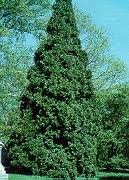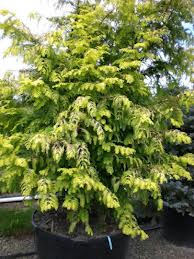Choosing conifer trees is a big deal. They’re expensive, permanent (hopefully) and they take up a lot of garden real estate. It’s no wonder new gardeners (and maybe not just new gardeners!) start to get nervous when making their choice. If not for this ongoing gardening education of mine, I would have never realized how many different sizes, colours and shapes of conifers there are.
Experienced gardeners take some knowledge for granted. (“You water the container when all the soil is dry, silly!” Or, “I’m sorry to disappoint, but there aren’t any perennials that bloom from spring to fall.”) Knowing how fast a tree grows and how to plant it may be information that others take for granted, but new gardeners have no clue about trees.

However, many beginner gardeners (but probably not enough) do know how important and valuable trees are. They offer shade, privacy, shelter for critters and a little hint of the majestic. To find out how to choose and plant conifers, I approached Darren Heimbecker at Whistling Gardens in Wilsonville, Ont., and JR Peters at Humber Nurseries in Brampton, Ont., with some beginner, and possibly obvious, questions. Part of my blog’s mission is to ask rooky questions. Sometimes I think I’m gaining a reputation at gardening companies and nurseries for dumb questions, but they took mine in stride.
I asked Darren and JR to recommend large, attractive, low-maintenance trees that grow quickly. Darren had lots of recommendations, (see below,) while JR had one particular favourite. For the best all-around conifer tree, JR suggested our native white cedar (Thuja occidentalis). It’s hardy to Zone 2, adapts to most conditions and is relatively problem free. It grows approximately 39 feet (12 m) tall and 7 feet (2 m) wide. Native trees are always a good choice, because they’re adapted to our growing conditions and climate.
If you’re looking for something a bit more unusual, or want more choices before making the big decision, here are Darren’s recommendations:
1) Lebanon cedar (Cedrus libani ssp. stenocoma): Growth rate of 20 inches (50 cm) a year. Height 60 feet (18 m) and width 20 feet (6 m). Hardy to Zone 5. It has blue/green needles (not unlike larches), but it doesn’t drop its needles.
2) Dawn redwood (Metasequoia glyptostroboides and cvs.): Fast growth rate of 2 to 3 feet (60 to 90 cm) a year. Height 60 feet (18 m) and width 15 feet (4.5 m). Hardy to Zone 4b. It has beautiful fall colours of oranges and russets.
‘Gold Rush’ — Brilliant yellow all season.

‘Kool’s Gold’ — A new cultivar that’s even brighter yellow.
‘Silhouette’ — Gold and green needles.
‘Waasland’ — Somewhat more narrow and formal looking.
3) Norway spruce (Picea abies and cvs.): Growth rate of 1 foot (30 cm)+ a year. Height 30 feet (9 m) and width 12 feet (3.5 m). Hardy to Zone 4.
Aureospicata — New growth is brilliant yellow that matures to dark green.
‘Rubra Spicata’ — New growth is deep red that matures to dark green.
4) Blue spruce (Picea pungens and cvs.): Growth rate of 1 foot (30.5 cm) a year. Height 40 feet (12 m) and width 20 feet (6 m). Hardy to Zone 2.
‘Gebelles Golden Spring’ — New growth is brilliant yellow that matures to rich green.
‘Spring Blast’ — New growth is white that matures to cobalt blue.
5) Limber pine (Pinus flexilis and cvs.): Hardy to Zone 4.
‘Vanderwolf’s Pyramid’ — Growth rate of 1.5 feet (45 cm) a year. Height 30 feet (9 m) and width 12 feet (3.5 m). It has a dense form with green and silver colouring.
‘Extra Blue’ — Growth rate of 1 foot (30 cm) a year. Height 30 feet (9 m) and width 12 feet (3.5m). Has pretty blue-grey colouring on the needles year-round.
6) Korean pine (Pinus koraiensis and cvs.): Darren especially likes ‘Oculus-Draconis’, ‘Silveray’, and ‘Morris Blue’. Growth rate of about 1 foot (30 cm) a year. All grow to about 30 feet (9 m) or taller and 12 feet (3.5 m) wide. Hardy to Zone 4. They have 6- to 8-inch (15- to 20-cm) beautiful silver, blue and green needles. Cones are highly ornamental and stay on the plants for several years. They’re all dense growing, making them a good choice for a windbreak as well as shelter for birds.
7) ‘Zebrina Extra Gold’ Western red cedar (Thuja plicata ‘Zebrina Extra Gold’): Growth rate of 2 feet (60 cm) a year. Height 30 feet (9 m) and width 8 feet (2.5 m). Hardy to Zone 5. Beautiful rich gold variegated foliage.
I also asked Darren and JR what size tree people (perhaps slightly impatient gardeners) should buy if they’re looking for something to fill a large space right away. Darren suggested a 5-foot (1.5 m) tree as a good option because it has a visual impact right away. JR told me that the largest size you can buy at Humber Nurseries (and likely other nurseries, as well) is 10 feet (3 m). However, if the gardener has a bit more patience, 3-, 5-, and 7-gallon size pots are more affordable. The smallest size you could find in most nurseries is a sapling at almost 3 feet (90 cm) tall.
Of course, every species of tree will have different requirements and preferences when it comes to planting, but I asked for some basic tips from JR and Darren. JR told me that conifers can generally be planted at any time of the year, as long as the ground isn’t frozen. Darren said his favourite times to plant conifers are the early spring and fall, with September being his number one choice. This is because the trees will be able to root for about eight weeks before the ground is frozen.
Conifer trees like rich, moist, well-drained soil. Keep them well watered the first year or two, until they get established. If Mother Nature isn’t being helpful, give them a good soaking once a week — three or four buckets of water, depending on the size of the rootball, should be about right.
When deciding where to plant your new tree, leave enough room for its full width when it matures. Conifers are rarely pruned, so make sure it can spread out on all sides and not block windows or paths. The size of the planting hole depends on the size of the tree’s root ball. Dig a hole twice as wide as its diameter and no more than a few inches deeper than the height of the root ball. When planted, the top of the root ball should be at ground level or a tiny bit higher. For more tips, check out Garden Making’s article on how to plant a tree.
Choosing a tree can be one of the first landscaping decisions a new homeowner makes, but whether you’re designing a new garden or imagining the hidden potential of your current backyard, hopefully you’ll be able to find the tree that gives you the size, shade, privacy and colour you want, and will fit your garden perfectly.









Hi Julie,
I’m happy to hear that there is at least one perennial that blooms for almost the entire season!
The heights and widths that I posted for the trees in this post are for when they are considered mature, which is at 25 years old. Darren agrees that the Dawn redwood can grow to 100 feet tall, and of course trees don’t suddenly stop growing after 25 years, but the mature heights and widths given for trees are typically for when they reach 25 years old.
-Kat
There is ONE perennial that blooms from spring to fall!! Geranium Rozanne. Mine started in May and is still blooming fairly profusely. Also I’m not familiar with all the statistics on the various tree cultivars that you mention but I do know that Dawn Redwood gets FAR larger than you said. 15 feet wide? Maybe on one side of the trunk. LOL! They can get well over 100′ tall and about 40′ wide (maybe more!) You need a REALLY big lot to handle this beautiful tree.